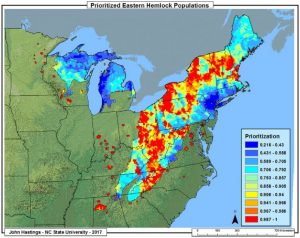
Maps show prioritized locations for seed collection from eastern hemlock populations. Red indicates the highest priority.
Eastern and Carolina hemlock trees in more than 400 counties across 19 states are dead, dying, or threatened by infestation of the invasive hemlock woolly adelgid.
As the aphid-like pest continues to spread throughout the ranges of these economically and ecologically important trees, scientists, managers, and other specialists from North Carolina State University’s (NCSU) Camcore program are racing to collect and store seeds with support from the U.S. Forest Service.
New maps can help them and other conservationists prioritize locations for seed collection, necessary for off-site plantings and breeding programs designed to restore hemlocks in the future.
“Once successful adelgid management techniques are in place, the availability of diverse genetic material for planting and breeding is critical for successful hemlock restoration,” says Kevin Potter, a cooperating scientist with the U.S. Forest Service Eastern Forest Environmental Threat Assessment Center, “because genetic diversity provides a basis for adaptation and resilience to environmental stress and change.”
Potter and NCSU researchers John Hastings, Robert Jetton, and Mark Megalos as well as Eastern Threat Center research ecologist Frank Koch applied a novel approach known as multi-attribute frontier mapping to identify priority seed collection locations across the entire range of both hemlock species.
Results were recently published in the journal New Forests.
For more information, see this U.S. Forest Service Southern Research Station blog post.
March 23, 2017




